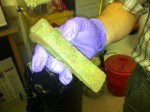 This has been a banner year for Jersey Island archaeology. This summer metal detectorists discovered a massive hoard of approximately 70,000 Celtic coins weighing three quarters of a ton, and now another metal detector enthusiast has discovered a hoard of a different color: a pottery vessel from the late Bronze Age (ca. 1000 B.C.) containing metal tools in excellent condition.
This has been a banner year for Jersey Island archaeology. This summer metal detectorists discovered a massive hoard of approximately 70,000 Celtic coins weighing three quarters of a ton, and now another metal detector enthusiast has discovered a hoard of a different color: a pottery vessel from the late Bronze Age (ca. 1000 B.C.) containing metal tools in excellent condition.
 Ken Rive, a member of the Jersey Metal Detecting Society, has been scouting the island for 20 years. He’s found small pieces of gold and silver, the occasional coin, but nothing of historical import. This time he was exploring a field in the northeastern parish of Trinity when his metal detector alerted. Less than a foot under the surface, he unearthed two bronze axe heads in pristine condition. Underneath the axe heads there was a pottery vessel. Rive realized the axe heads were once inside the vessel up near the lip and had been dislodged at some point.
Ken Rive, a member of the Jersey Metal Detecting Society, has been scouting the island for 20 years. He’s found small pieces of gold and silver, the occasional coin, but nothing of historical import. This time he was exploring a field in the northeastern parish of Trinity when his metal detector alerted. Less than a foot under the surface, he unearthed two bronze axe heads in pristine condition. Underneath the axe heads there was a pottery vessel. Rive realized the axe heads were once inside the vessel up near the lip and had been dislodged at some point.
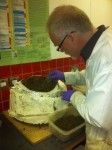 It was clear to him that this could be a find of historical significance, so he contacted Jersey Heritage and the Société Jersiaise. They dispatched Jersey Heritage’s Curator of Archaeology Olga Finch, conservator Neil Mahrer (who actually commented on the earlier post about the Celtic hoard, so if he’s reading this one too, hi Neil!), and Robert Waterhouse of the Société Jersiaise to excavate the pottery vessel in the trench. Ken Rive also got to help dig, lucky duck.
It was clear to him that this could be a find of historical significance, so he contacted Jersey Heritage and the Société Jersiaise. They dispatched Jersey Heritage’s Curator of Archaeology Olga Finch, conservator Neil Mahrer (who actually commented on the earlier post about the Celtic hoard, so if he’s reading this one too, hi Neil!), and Robert Waterhouse of the Société Jersiaise to excavate the pottery vessel in the trench. Ken Rive also got to help dig, lucky duck.
The excavation found that the top of the pot had been damaged by a plough, which is why the axe heads were loose while the rest of the pot contents are compacted with mud. A large number of pottery fragments not belonging to this hoard vessel were also found in the trench, suggesting that perhaps there’s more to be discovered in this spot.
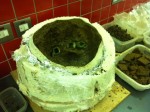 To ensure that they would be able to remove the delicate vessel intact from the earth, as more of it was exposed in the digging, the team wrapped a bandage around it until at the end the entire thing was swaddled like the head of a mummy, as Neil Mahrer puts it. Once the vessel was fully exposed and mummy-wrapped, they wrapped it in a layer of plastic wrap, then in a layer of aluminum foil and finally sprayed a foaming polyurethane all over it. That hardened into a thick insulating cocoon which kept the pot intact and tightly in place so the team could lift it safely and take it to the conservation lab.
To ensure that they would be able to remove the delicate vessel intact from the earth, as more of it was exposed in the digging, the team wrapped a bandage around it until at the end the entire thing was swaddled like the head of a mummy, as Neil Mahrer puts it. Once the vessel was fully exposed and mummy-wrapped, they wrapped it in a layer of plastic wrap, then in a layer of aluminum foil and finally sprayed a foaming polyurethane all over it. That hardened into a thick insulating cocoon which kept the pot intact and tightly in place so the team could lift it safely and take it to the conservation lab.
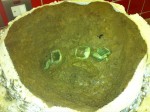 The vessel is now in the Jersey Heritage lab where Neil Mahrer is carefully excavating the contents. It’s about a foot in diameter and the size of a football (as in soccer). The axe heads have been identified as socketed axe heads, meaning they were cast with loops near the back of the head to provide a more secure means of fixing them to a wooden handle. This technology was developed around 1000 B.C., a thousand years into the history of Bronze Age metallurgy. Researchers believe there are more of them inside the pot. Some bronze pieces are beginning to show, but none have been fully uncovered or identified yet.
The vessel is now in the Jersey Heritage lab where Neil Mahrer is carefully excavating the contents. It’s about a foot in diameter and the size of a football (as in soccer). The axe heads have been identified as socketed axe heads, meaning they were cast with loops near the back of the head to provide a more secure means of fixing them to a wooden handle. This technology was developed around 1000 B.C., a thousand years into the history of Bronze Age metallurgy. Researchers believe there are more of them inside the pot. Some bronze pieces are beginning to show, but none have been fully uncovered or identified yet.
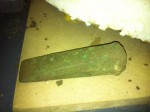 According to Olga Finch, late Bronze Age hoards have been found before in Jersey, among them founder’s hoards, collections of scrap metal pieces that were destined to be melted down and recast. This hoard is highly unusual, however, because the axes are in like-new condition, suggesting that this pot may not have been the possession of a farmer buried for safekeeping from marauders, but rather the merchandise of a traveling salesman. Bronze was extremely valuable, and this much high quality bronze in one container would have been prohibitively expensive for most people to own outright.
According to Olga Finch, late Bronze Age hoards have been found before in Jersey, among them founder’s hoards, collections of scrap metal pieces that were destined to be melted down and recast. This hoard is highly unusual, however, because the axes are in like-new condition, suggesting that this pot may not have been the possession of a farmer buried for safekeeping from marauders, but rather the merchandise of a traveling salesman. Bronze was extremely valuable, and this much high quality bronze in one container would have been prohibitively expensive for most people to own outright.
Since they’ve been fortunate enough to find the vessel intact and excavate it in situ, researchers hope their careful, thorough cleaning and opening of the vessel and its contents will give them some answers about the hoard, its role and why it was buried. It will be months before they’re done removing, recording and analyzing the contents of the pot. Once they’re out and cleaned, Jersey Heritage hopes they’ll be able to put the hoard on display as soon as next summer.
Click here to see video of the find as it was excavated, including the mummy wrapping of the pot, the application of the hardening polyurethane foam and the whole shebang at the lab complete with bags and bags of pottery fragments. It’s amazing how much they found in such a small excavation trench.
It’ll be neat to follow this one, especially if there’s more field excavating (and finds) to come!
My guess is that we have to deal here with a clear case of bronze age tax evasion – its the channel islands.